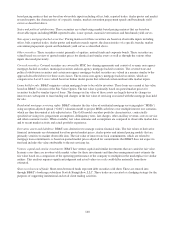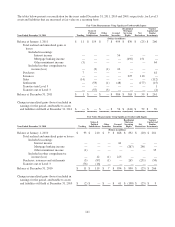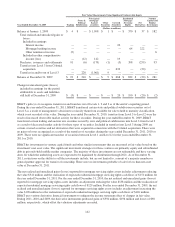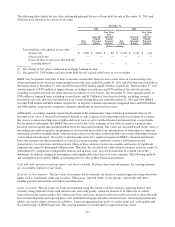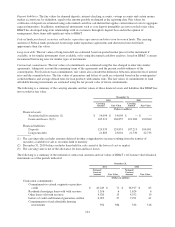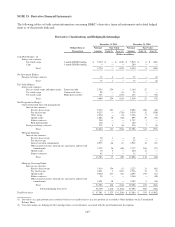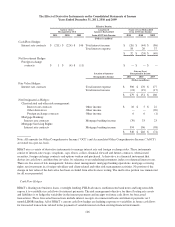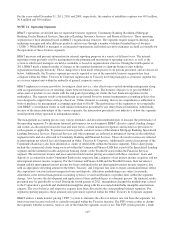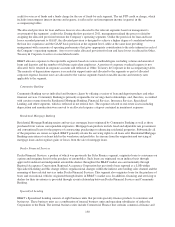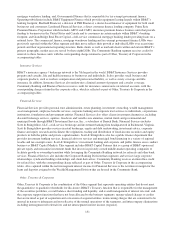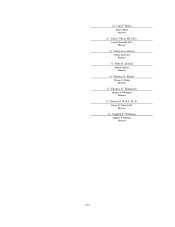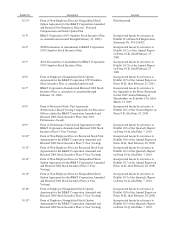BB&T 2011 Annual Report Download - page 149
Download and view the complete annual report
Please find page 149 of the 2011 BB&T annual report below. You can navigate through the pages in the report by either clicking on the pages listed below, or by using the keyword search tool below to find specific information within the annual report.For the years ended December 31, 2011, 2010 and 2009, respectively, the number of antidilutive options was 40.9 million,
36.8 million and 38.6 million.
NOTE 21. Operating Segments
BB&T’s operations are divided into six reportable business segments: Community Banking, Residential Mortgage
Banking, Dealer Financial Services, Specialized Lending, Insurance Services, and Financial Services. These operating
segments have been identified based on BB&T’s organizational structure. The segments require unique technology and
marketing strategies and offer different products and services through a number of distinct branded lines of business
(“LOBs”). While BB&T is managed as an integrated organization, individual executive managers are held accountable for
the operations of these business segments.
BB&T measures and presents information for internal reporting purposes in a variety of different ways. The internal
reporting system presently used by management in the planning and measuring of operating activities, as well as the
system to which most managers are held accountable, is based on organizational structure. During the fourth quarter of
2011, BB&T made a limited number of changes to the segment definitions to align the business units with the
organizational manager hierarchy. These changes have been made retrospective to all periods presented, and are discussed
below. Additionally, the Treasury segment previously reported as one of the reportable business segments has been
collapsed within the Other, Treasury & Corporate segment due to Treasury not being managed as a business segment but
as a service support unit within the umbrella of general corporate services.
BB&T emphasizes revenue growth by focusing on client service, sales effectiveness and relationship management along
with an organizational focus on referring clients between business units. The business objective is to provide BB&T’s
entire suite of products to our clients with the end goal of providing our clients the best financial experience in the
marketplace. The segment results contained herein are presented based on internal management accounting policies that
were designed to support these strategic objectives. Unlike financial accounting, there is no comprehensive authoritative
body of guidance for management accounting equivalent to GAAP. The performance of the segments is not comparable
with BB&T’s consolidated results or with similar information presented by any other financial institution. Additionally,
because of the interrelationships of the various segments, the information presented is not indicative of how the segments
would perform if they operated as independent entities.
The management accounting process uses various estimates and allocation methodologies to measure the performance of
the operating segments. To determine financial performance for each segment, BB&T allocates capital, funding charges
and credits, an allocated provision for loan and lease losses, certain noninterest expenses and income tax provisions to
each segment, as applicable. To promote revenue growth, certain revenues of Residential Mortgage Banking, Specialized
Lending, Insurance Services, Financial Services and other segments are reflected in noninterest income in the individual
segment results and also allocated to Community Banking and Financial Services. These allocated revenues are reflected
in intersegment net referral fees and eliminated in Other, Treasury & Corporate. Additionally certain client groups of the
Community Bank have also been identified as clients of other LOBs within the business segments. These client groups
include the commercial clients being serviced within the Commercial Finance LOB that is part of the Specialized Lending
segment and the identified wealth and private banking clients of the Wealth Division within the Financial Services
segment. The net interest income and associated net funds transfer pricing associated with these customers’ loans and
deposits is accounted for in the Community Bank in the respective line categories of net interest income (expense) and net
intersegment interest income (expense). For the Commercial Finance LOB and the Wealth Division, their net interest
margin and net intersegment interest income has been combined in the net intersegment interest income (expense) line
with an appropriate offsetting amount to the Other, Treasury, and Corporate line item to ensure consolidated totals reflect
the corporation’s total net interest margin for loans and deposits. Allocation methodologies are subject to periodic
adjustment as the internal management accounting system is revised and business or product lines within the segments
change. Also, because the development and application of these methodologies is a dynamic process, the financial results
presented may be periodically revised. During the fourth quarter of 2011, management changed the methodology related
to the Corporation’s goodwill and identifiable intangibles along with the associated identifiable intangible amortization
expense. The asset balances and respective expense have been allocated to the corresponding business segments. For
segment reporting purposes, these amounts were previously reported within the Other, Treasury & Corporate segment.
BB&T utilizes a funds transfer pricing (“FTP”) system to eliminate the effect of interest rate risk from the segments’ net
interest income because such risk is centrally managed within the Treasury function. The FTP system credits or charges
the segments with the economic value or cost of the funds the segments create or use. The FTP system provides a funds
149



